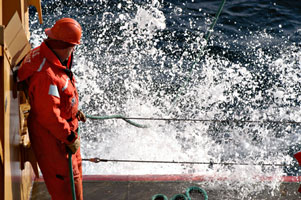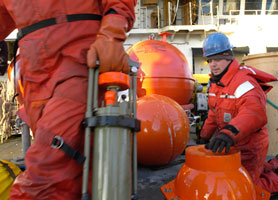 |
Daily Update
Calendar
Dispatch 12 - September 21, 2003
By C. A. Linder
Weather conditions: Clear skies, 25 kt winds, 3-5 ft seas,
air temperature 33°F
International Relations
An icy wind blasted me as I stepped out on deck today. A beautiful
sunrise beckoned from the fantail,
though, so I bundled up and grabbed my camera. As I was packing
up from the chilly sunrise photo shoot, my pager suddenly started
beeping. I checked the callback number - 999! That's the code that
people use to tell me "get your camera and get outside fast,
there's some wildlife out there!" Immediately I began my trek
up to the bridge, camera ready. On the third ladderway (stairwell)
something went whizzing over my head, faster than I could register.
I turned back and found a better vantage point on the flight deck.
To my amazement, the bird that had buzzed me on the ladder was an
owl! After firing off several shots as it flew loops around the
ship, I consulted some birding guides and determined that it was
a short-eared owl. I was surprised to learn that it's not uncommon
to spot arctic owls like short-eared and snowy owls as they fly
from island to island searching for lemmings, their primary food.
After lunch, we assembled on the fantail to recover
the University of Alaska, Fairbanks central channel mooring. Fingers
crossed, David Leech sent the command to release the mooring. Moments
later it popped to the surface. The Healy's zodiac
was lowered into the water and the boat crew drove out to the waiting
mooring. The wind and waves made the mooring recovery a tricky one
-- at one point the mooring got stuck under the ship's stern and the
small boat crew had to use a boat hook to drag
it out. The lengthy recovery had a happy ending, though - all
instruments recovered, all intact.
The mooring crew only had time for a quick dinner before they jumped
back into their mustang suits and headed back to the fantail. We had
to pick up one more mooring. This one was a short-term (2 month) mooring
that some Chinese colleagues had deployed this summer. They intended
to pick it up a few weeks ago, but bad weather forced them to return
home without their instruments. Since the mooring was quite small,
we hauled it in quickly and stored the precious instruments safely
on deck. Teamwork is critical in oceanography, and it was with great
pleasure that we were able to help out the Chinese scientists.
Nolan from Morse Pond School and
Carly from Varnum Brook Elementary
have similar questions about life at sea:
Questions: "What's life like on the ship?"
and "What is it like living on a boat rather than living in
Massachusetts?"
Answer: Life at sea is a unique experience. Life
on an icebreaker in the Arctic Ocean is even more unique. All of your
surroundings are different. The sights and smells of the earth are
replaced by the sights and sounds of the ship and the sea. I remember
getting off the icebreaker last year after four weeks at sea. The
first thing I did was walk in a straight line as far as I could! The
shopfronts all had beautiful flowers, and I think I stopped to smell
every one. It's amazing how accustomed you get to the smell of the
ocean and the ship. Since going to sea is a very personal experience,
I decided to ask two people from very different backgrounds to share
their thoughts.
Martha Delaney's Answer: "Since I have never
been out to sea before, living on the Healy seems VERY different
to me than living in Massachusetts. One thing that really strikes
me is how much I miss the everyday things at home, for instance, my
dog, Linus. The crew can't have pets like dogs or cats but they do
have a pet millipede! She lives in an aquarium and she is fed hermit
crab food and water. At home, I would get into my car to go anywhere
-- the grocery store, the woods to walk my dog, or the beach...on
the Healy, there is nowhere to go! You can go up or down,
fore or aft, but that's it. This ship is very large but you soon learn
every nook so it doesn't seem so big after a while.
Bob Pickart's Answer: "I've been to sea a fair
number of times over the years, and it still never ceases to amaze
me. Even though Cape Cod is on the water, the deep ocean is so much
different---from the color of the water, to the sea life, to the clouds
in the sky. Here in the Arctic it's even more strange (as you've been
learning from Chris' wonderful dispatches). As far as daily life is
concerned, there are many differences from being ashore. For instance,
you work everyday (weekends don't mean anything at sea) so it is easy
to lose track of what day it is. All your meals are cooked for you,
and you can't walk very far in one direction! Normally I would say
that you also have to get used to rocking back and forth with the
swell of the water, but the ship we're on is so big that sometimes
it feels as if we're on land!"
 |
 |
 |
| David Leech narrowly
misses a soaking when a large wave hits the fantail. |
John Kemp (foreground)
and Ryan Schrawder (background) disassemble the Chinese mooring. |
| Click
to enlarge |
Click
to enlarge |
I have two other excellent questions from Mrs. Rodgers' class
at the Morse Pond School.
Question from Brianna: Is the Healy staying
in one spot or moving around?
Answer: The Healy stops when we are doing
science - CTD casts or mooring redeployments. The ship may also stop
for periodic short maintenance checks. Otherwise we're on the move
- steaming to the next science station. To see a map of where we have
been, be sure to check the current position
button. Keep in mind that I only update the map every 2 days or so,
and due to security reasons the most recent position is 48 hours old.
Question from Ally: What is the time difference between where you are and Falmouth, MA?
Answer: Hi Ally, we are four hours behind Falmouth.
When it is noon in Falmouth it is only 8AM here! This time zone is
known as the Alaska zone -- it's one hour west of Pacific.
Tonight the CTD watch hopes to complete a west to east section across
the central Chukchi Sea. After that, we will redeploy the central
channel mooring and begin heading north, to the edge of the arctic
shelf, and (hopefully) to the ice.
 Previous
Dispatch Next Dispatch Previous
Dispatch Next Dispatch

Back to
Calendar
|




